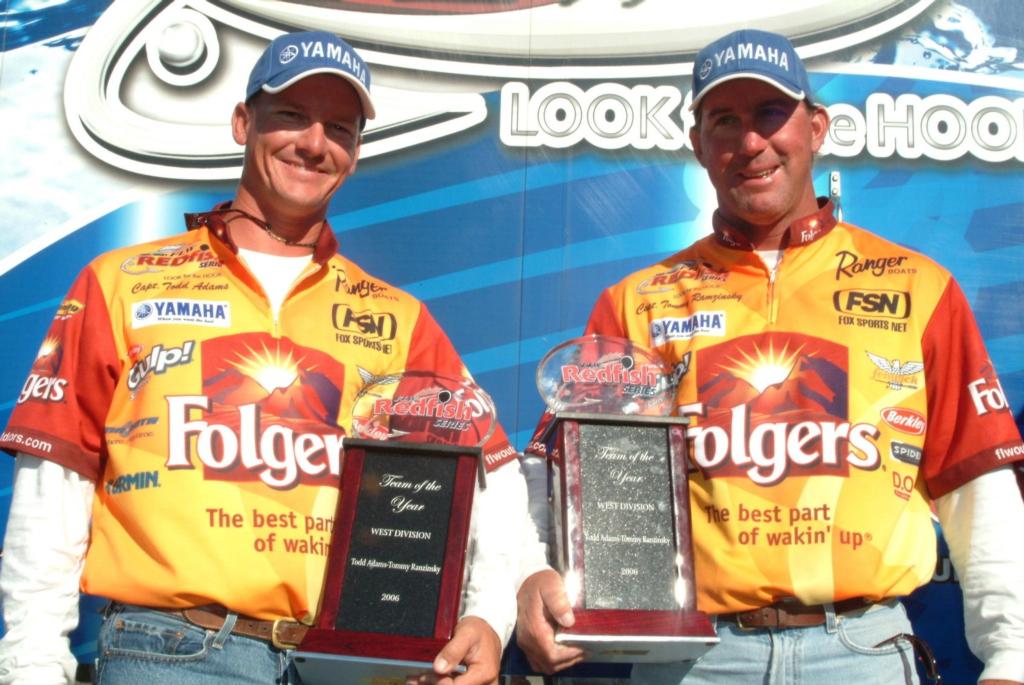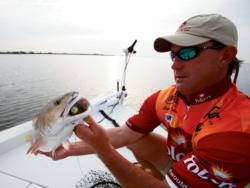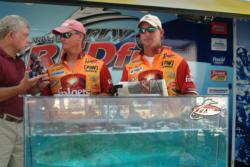Redfishing’s wonder boys
FLW Redfish Series Western Division Team of the Year takes a look back at their amazing ’06 season

Tournament bass fishing and tournament redfishing are similar in many respects, with one big exception: the slot limit.
Bass anglers are allowed to cull up their five-bass limits with the absolute biggest bass they can catch, but redfish anglers are contained by size limits on redfish.
While exact slot limits vary with regulations from state to state, in general, slot limits start in the 16- to 17-inch mark and extend to the 27- to 28-inch mark. Any redfish inside this range can be kept, while any redfish outside this range must be released.
As a result, tournament redfish anglers are always in search of what they call “the right fish,” meaning fish that register in the extreme upper end of the slot without going over the dreaded line of demarcation.
Also, the tournament creel limit on redfish is one per person, or two per team.
Given the slot-limit-confined world of tournament redfishing, it’s hard to imagine being able to consistently catch two redfish as close to the 27- or 28-inch range as possible day after day, tournament after tournament.
But that’s exactly what the team of Todd Adams and Tommy Ramzinsky of Rockport, Texas, did last season along the Wal-Mart FLW Redfish Series Western Division schedule.
In four tournaments, the team’s finishes included first, fourth, seventh and fifth, respectively, giving them the Western Division points title with a total of 587 points, just 13 points short of a perfect season.
And their accomplishments go even further back than that. In 2005, they won the Redfish Series Championship in Orange Beach, Ala.
So what’s the secret to this dynamic duo of tournament redfishing?
 For starters, like many great anglers, both Adams and Ramzinsky were brought up in fishing families. Both of their fathers introduced them to the sport as youngsters.
For starters, like many great anglers, both Adams and Ramzinsky were brought up in fishing families. Both of their fathers introduced them to the sport as youngsters.
Ramzinsky, who lived in Gonzales, Texas, as a child, was raised on bass fishing while his future team partner, Adams, was raised on the Texas coast, deck handing for his father’s charter guide business in Rockport.
Later, when Ramzinsky’s family moved to Rockport, it didn’t take long for the two boys’ common fishing interests to bring them together.
“Rockport is a fishing community,” Adams recalled about their teenage years. “All we did was fish and hunt. When Tommy moved there, he fit right in with our whole Rockport Gang because he loved the outdoors too.”
Actually, the “Rockport Gang” includes a host Redfish Series Western big sticks including Danny Adams (Todd’s brother) and Billy Nicholas; Mike Patterson and Brett Phillips; Darrell and Robert Walter; David Nesloney Sr. and Jr.; and Jeff Steckler and Ryan Watkins.
“As kids we were all friends, and we spent days wade-fishing up and down the Texas coast,” Adams continued. “We didn’t have boats or fancy equipment, and we didn’t care. We all loved fishing, and wading was big time for us.”
As the Rockport Gang grew up, many of them, including Adams and Ramzinsky, took up the rich Rockport tradition of charter guiding on the Texas coast. Though most of their guiding centers on sea trout, they spend a lot of time on inshore waters studying the marine environment.
 “Like a lot of us in Rockport, Tommy and I have been guiding 200-plus days a year for 10 years,” Adams said. “And like all the bass pros say, there’s no substitute for time on the water.”
“Like a lot of us in Rockport, Tommy and I have been guiding 200-plus days a year for 10 years,” Adams said. “And like all the bass pros say, there’s no substitute for time on the water.”
The Rockport teams work together at new venues, which gives them a big advantage.
“When the Redfish Series comes here to Rockport, we don’t need to work together because we all know the waters so well,” Ramzinsky said. “But when we go over to cover the vast marshes in Louisiana, working together with other teams is a huge plus for all of us. All of the teams from Rockport made the championship this year.”
If on-the-water experience provides the bricks of their success, then team chemistry is the mortar. Adams and Ramzinsky have an enviable friendship and partnership that floods their boat with confidence.
The team has discovered that a critical aspect of their successful tournaments is time spent scouting together, not apart.
“I know a lot of teams that scout in two different boats, and that works great for them, but we can’t do that,” Ramzinsky explained. “Todd and I have to be on the same page to make effective decisions. Our eyes have to see the same water at the same times during practice, so we know exactly what each other is thinking when we put a tournament strategy together.
 “Teams that scout separate water in separate boats might cover more water than us in practice, but then they have to overcome that gap in communication on what each other has found. If one guy’s water doesn’t pan out, the other guy is left feeling like they should have gone to his fish. Then problems can arise in the team dynamic.
“Teams that scout separate water in separate boats might cover more water than us in practice, but then they have to overcome that gap in communication on what each other has found. If one guy’s water doesn’t pan out, the other guy is left feeling like they should have gone to his fish. Then problems can arise in the team dynamic.
“We never let it get to that level, because every decision we make is based on what we have both observed at the same time – for us that’s pretty effective. Our ability to eliminate bad water and totally commit, without a shadow of a doubt, to the best water we have is probably one of our strengths.”
When the team talks about “commitment to an area,” it refers to an important facet of tournament redfishing.
“So many times, we’ll make a sizeable run to our area and only have three or four hours to fish,” Adams related. “And within that period of time we expect to get maybe three to six bites. Well, we might not get those bites until the last 20 minutes.
 “The real discipline in commitment comes in those first three hours that we are fishless. With each passing minute, your head starts telling you to go elsewhere, your foot wants to go faster on the trolling motor, and your retrieve speed is getting faster. Pretty soon you’re fishing right over opportunities before they present themselves.
“The real discipline in commitment comes in those first three hours that we are fishless. With each passing minute, your head starts telling you to go elsewhere, your foot wants to go faster on the trolling motor, and your retrieve speed is getting faster. Pretty soon you’re fishing right over opportunities before they present themselves.
“Tommy and I keep each other calm and settled by saying, `OK, we know these fish are here. There is no need to get in a rush; let’s just stake down and wait them out.'”
“A lot of that comes from our years as wade-fishermen,” Ramzinsky offered. “When we first started fishing out of boats, we were terrible at catching redfish from a boat. We soon realized the reason: We were moving too fast and not making the critical presentations we used to achieve when we wade-fished.
“When wade-fishing, you are forced to slow down and really explore every nook and cranny. When you’re in a boat and the wind is blowing you across a flat, or you can stand on a trolling motor down a bank, being meticulous takes a back seat.
“During tournaments last year, Todd and I really returned to our wade-fishing roots. That’s not to say we got out of the boat and waded, obviously, but we made a conscious effort to move down productive shorelines at a snail’s pace, just like we were wading.”
“And when we come in with two nice redfish, the automatic assumption is that we burned up the  water and culled all day,” Adams added. “Sometimes, those two fish were the only ones we caught, and we got them in the last few minutes in a tiny area that we fished all day.”
water and culled all day,” Adams added. “Sometimes, those two fish were the only ones we caught, and we got them in the last few minutes in a tiny area that we fished all day.”
The Texas team also believes that their fishing style – fishing deeper water in 2 to 4 feet, instead of shallow sight-fishing – contributed to their success in 2006.
“In our opinion, the hardest fish to catch are supershallow ones you can see,” Ramzinsky explained. “In general, deeper redfish, relating to water in the 2- to 4-foot range are less pressured, more comfortable and more reliable.
“If we can find `hidden’ fish in potholes, along channel breaks or in troughs, we get pretty excited. Those are the kind of fish that can make you a hero over a three-day period. That’s the situation we had when we won the Redfish Series Championship in 2005.”
That said, both Adams and Ramzinsky agree that they prefer to stay away from Florida.
“We have not fished in Florida and don’t really care to,” Adams said. “Poling around in inches of water, trying to make a redfish bite, is not our style.”
Looking ahead to the coming year, Adams and Ramzinsky plan to compete in the Redfish Series Western Division again and claim there is no pressure to outperform their 2006 season in 2007.
“We had a great year in 2006, no doubt, but we’re not looking into 2007 and thinking we’ve got to have a better year than last year,” Ramzinsky said. “We’re not out here to impress anyone. The bottom line is Todd and I just love fishing, especially inshore coastal fishing, and we eagerly look forward to fishing each tournament day. We might bomb, we might make a top five, we might win – either way, at the end of the day we’re satisfied in knowing we fished the best water we had, we made the best decisions possible, and we fished to the best of our abilities.”